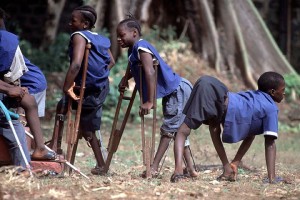Poliomyelitis (polio) is a highly infectious disease caused by a virus. It invades the nervous system, and can cause total paralysis in a matter of hours.
 Until the 1950s, polio crippled thousands of children every year in industrialised countries. Soon after the introduction of effective vaccines in the late 1950s (IPV) and early 1960s (OPV), polio was brought under control, and practically eliminated as a public health problem in industrialised countries.
Until the 1950s, polio crippled thousands of children every year in industrialised countries. Soon after the introduction of effective vaccines in the late 1950s (IPV) and early 1960s (OPV), polio was brought under control, and practically eliminated as a public health problem in industrialised countries.
It took somewhat longer for polio to be recognised as a major problem in developing countries. However, ‘lameness surveys’ during the 1970s revealed that the disease was also frequent in developing countries, crippling thousands of children every year. As a result, during the 1970s routine immunization with OPV as part of national immunization programmes (Expanded Programme on Immunization, or EPI programmes) was introduced worldwide, helping to control the disease in many developing countries.
Today, the disease has been eliminated from most of the world, and only three countries worldwide remain polio-endemic (Nigeria, Pakistan and Afghanistan).
During the peak epidemics of polio in Australia from the 1930’s to the 1960’s, significant numbers of Australians experienced paralytic polio (between 20,000 and 40,000 people). This figure must be increased 200-fold to obtain the estimated number of infected cases during the same period.[1,2,3] The original epidemic population is now an ageing one, and an increasing number of these individuals are now living with a range of symptoms and chronic conditions which may be attributable to the original polio infection, as well as the challenges of living with the effects of ageing with disability.[4,5]

Whilst global polio eradication efforts have been effective in stemming outbreaks, in Australia we are also now seeing recorded incidences of younger people, particularly migrants from developing nations (or nonwestern nations), who contracted polio overseas. It may be anticipated that with an increasing global community, and ongoing immigration into Australia, in the years to come these people will likely present to health professionals with various chronic conditions related to their initial polio infection.
To learn more about polio, its late effects including post-polio syndrome, and to include your polio details on the Australian Polio Register, please browse the other pages in this section of the website.
—————-
References / Downloads
[1] World Health Organization, Global Polio Eradication Initiative.
[2] US Centers for Disease Control, Epidemiology and Prevention of Vaccine-Preventable Diseases, 2015.
[3] Polio Australia Position Paper, Numbers of polio survivors living in Australia, April 2014. (2 pages, 170.8 KB).
[4] Le Boeuf C, The Late Effects of Polio: Information for Healthcare Providers, Commonwealth Department of Community Services and Health, Woodville, 1991.
[5] House of Representatives Standing Committee on Health and Ageing, Discussion paper on the late effects of polio/post-polio syndrome, June 2012. (66 pages, 691.2 KB)


